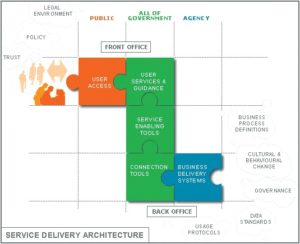 Government of New Zealand has taken a lot of steps towards largescale implementation of ICTs for transforming public services. Could you briefly trace the path of this transformation?
Government of New Zealand has taken a lot of steps towards largescale implementation of ICTs for transforming public services. Could you briefly trace the path of this transformation?
By the mid-1990s most New Zealand government departments had established a web presence, and the benefits promised by ICT were being enthusiastically embraced and e-Government was being ushered into the country. However, this early development of online services was not centrally driven or coordinated, and that individual departments and agencies developed their own online initiatives. There was no overall strategy and no single point of entry for government services online. The beginning of a more coordinated approach came in 1995 when the Ministry of Commerce (now the Ministry of Economic Development) launched the first online government directory. In 1997, this directory was merged with the Department of Internal Affairs’ online Blue Pages project becoming the New Zealand Government Online website – the precursor to www.govt.nz, the current All-ofgovernment web portal.
The State Services Commission (SSC) established an IT Policy Taskforce in 1997 recognising the need for a more strategic approach to the government’s online presence. The Government was advised to develop a guiding vision for online services and initiate the development of a sector-wide strategy by the taskforce, which worked in association with the Chief Executives’ Group on Information Management and Technology. Culminating with a Vision Statement in May 2000 that outlined a strategic direction for e-Government in New Zealand and addressed some of the issues around its implementation, the taskforce subsequently issued a number of significant policy documents.

“Public-private partnerships as such have not been a feature of e-Government development in New Zealand.”
Following the Government’s adoption of the Vision Statement, the e-Government Unit was formally established in the SSC on 1st July 2000. The Unit’s responsibilities were: Strategy – development of overarching e-Government strategy, and common system and data management policies, standards and guidelines; Leadership – facilitate the uptake by government agencies of the e-Government vision and information system and data management policies, standards and guidelines; Coordination/Collaboration – identify opportunities for beneficial collaboration across government agencies, leverage better returns from existing information management and technology investment, and provide coordination for multi-agency e-Government projects; Policy – provide advice to the Minister of State Services in relation to e-Government; and, Monitoring – monitor progress toward achieving the e-Government vision, and progress on information management and technology investment (the latter function being an extension of the SSC’s existing role in scrutinising public service capacity investments).

A new Information and Communication Technologies Branch was established on 1st July 2005 to undertake the work of the e-Government Unit as part of the reorganisation of the SSC. This acknowledged that e-Government had now become a part of the mainstream, or core, work of the SSC.
Government of New Zealand has projected a vision of making intelligent networks and Internet as integral parts of government functioning and information/service delivery by 2007 and reforming government operations by 2010. How do you think the government is performing towards achieving these objectives?
The New Zealand e-Government Strategy, as revised in June 2003, has set out three key milestones. By June 2004, the Internet will be the dominant means of enabling ready access to government information, services and processes; by June 2007, networks and Internet technologies will be integral to the delivery of government information, services and processes; and, by June 2010, the operation of government will have been transformed through its use of the Internet.
Government departments across the board are making good progress towards the e-Government goals, according to a report on the achievement of the 2004 milestone. Obviously, there are some departments particularly those with a more service-oriented focus that are quite advanced, and there are some departments that are not as far down the road, generally due to the nature of their core business. Quite importantly, the report describes the overall picture as a positive one though some of the findings were not positive. The review also
identified how departments could improve their web presence or areas where they could more closely align with the Strategy.
What is the current IT infrastructure situation in the country? Is it well established or a lot more needs to be done?
Although New Zealand has a welldeveloped IT infrastructure, but there is still more to be done. The Digital Strategy, which was launched in May 2005, has set its eye to make New Zealand a world leader in using information and technology to realise its economic, social, environmental, and cultural goals, to the benefit of all its people. The three enablers of the Digital Strategy are Connection, Confidence and Content. Connection is necessary but not sufficient – it simply provides the means; Confidence gives the skills and a secure online environment; whilst accessing or creating Content provides a compelling reason to make it
happen.
“The New Zealand Government policy says that there is no reason inherent in open source licensing why government agencies should not consider open source software on the same basis as commercial software. Agencies should make decisions on the use of software on cost, function, interoperability, and security grounds.”
The challenges of connection are that New Zealand has high Internet usage but low broadband uptake, and that New Zealand’s small market inhibits investment and limits competition. Broadband is therefore a critical part of our infrastructure. Moderate-speed broadband with broad coverage is not enough. Our businesses and researchers need higher speed and more affordable broadband to compete and connect globally. Digital technology and the convergence of broadcasting and communications have opened up exciting new ways to deliver content such as digital TV with new challenges and opportunities in broadcasting as much as telecommunications. Opportunities also arise from the convergence of telecommunications and IT. Wireless solutions also offer a way of increasing competition between different kinds of technology, which is important in a small market for developing innovative, lowcost services.
The government being a large network user and significant purchaser can also help drive demand. The government also intends to raise people’s awareness of the benefits of broadband and has set clear targets for broadband speed and coverage, benchmarked against the OECD, under the Digital Strategy. In e-Government, infrastructure developments include the management of standards to encourage and enable interoperability, processes for an All-ofgovernment authentication system, and a government-shared network.
What strategies are adopted by the New Zealand Government for IT capacity building within the Government and among the public?
 The Digital Strategy recognises that developing skills and capability is essential for achieving the goals of the Strategy, and the government is already investing heavily in education and skills training through both the education system in schools, polytechnics and universities, and also through encouraging workplace training. Within the government sector, the e-Government programme has been working with universities to develop an e-Government component degree courses as well as short courses aimed at enhancing awareness and capability among State servants.
The Digital Strategy recognises that developing skills and capability is essential for achieving the goals of the Strategy, and the government is already investing heavily in education and skills training through both the education system in schools, polytechnics and universities, and also through encouraging workplace training. Within the government sector, the e-Government programme has been working with universities to develop an e-Government component degree courses as well as short courses aimed at enhancing awareness and capability among State servants.
What initiatives have been taken in New Zealand for effective use of PPP models?
Public-private partnerships as such have not been a feature of e-Government development in New Zealand.
What is the policy and vision of New Zealand with respect to open source deployment in public sector enterprises and departments?
The New Zealand Government policy is that there is no reason inherent in open source licensing why government agencies should not consider open source software on the same basis as commercial software. Agencies should make decisions on the use of software on cost, function, interoperability and security grounds. Much information is available, on public websites and from private IT analysis services to help agencies evaluate their software options. Agencies should assess alternatives whenever they are considering upgrades or relicensing existing software.
What has been the progress of New Zealand in terms of evolving from ‘e’ to ‘m’-Government? What are the future plans in this respect?
Service-delivery agencies make decisions on the use of particular delivery channels including mobile/cell phone delivery. A number of agencies are making use of text messaging and cell phone alerts in their service delivery packages. The ICT Branch is supporting agencies in this
process through the development of a channel framework to assist in decisionmaking, and through the negotiation of a syndicated procurement contracts with Telecom and Vodafone for the supply of cellular services, expected to realise savings of up to 20% for participating government agencies.
“The government has committed up to US$400mn to digital programmes, including US$44.7mn in contestable seed funding to implement key partnership initiatives in two streams – the Broadband Challenge (US$24mn) and the Community Partnership Fund (US$20.7mn).”
What policy measures and strategieshave New Zealand Government formulated for ensuring largescale penetration of Internet among the masses? What has been the effort towards bridging digital divide among different sections of the society?
 Considering that New Zealand would become a world leader in using information and technology, the Digital Strategy includes specific initiatives to ensure that technology is available to and used by all sections of New Zealand society. In particular, the government has committed up to US$400mn to digital programmes including US$44.7mn in contestable seed funding to implement key partnership initiatives in two streams – the Broadband Challenge (US$24mn), to enable affordable broadband roll-out based on competitive open-access principles; and, the Community Partnership Fund (US$20.7mn), to support grassroots initiatives that will build ICT skills in communities and regions and help create distinctive New Zealand content.
Considering that New Zealand would become a world leader in using information and technology, the Digital Strategy includes specific initiatives to ensure that technology is available to and used by all sections of New Zealand society. In particular, the government has committed up to US$400mn to digital programmes including US$44.7mn in contestable seed funding to implement key partnership initiatives in two streams – the Broadband Challenge (US$24mn), to enable affordable broadband roll-out based on competitive open-access principles; and, the Community Partnership Fund (US$20.7mn), to support grassroots initiatives that will build ICT skills in communities and regions and help create distinctive New Zealand content.
What monitoring and evaluation measures, success indicators and ROI estimation parameters have been put in place by the Government for reviewing such projects?
e-Government initiatives are undertaken by government agencies as part of their normal business processes to provide more efficient and effective services and to improve business delivery. Accordingly, monitoring and evaluation is covered by the standard performance assessment processes of the New Zealand Public Management System. In addition, the ICT Branch of the State Services Commission evaluates the extent to which e-Government activities collectively contribute to the achievement of the e-Government milestones.
Be a part of Elets Collaborative Initiatives. Join Us for Upcoming Events and explore business opportunities. Like us on Facebook , connect with us on LinkedIn and follow us on Twitter, Instagram.











